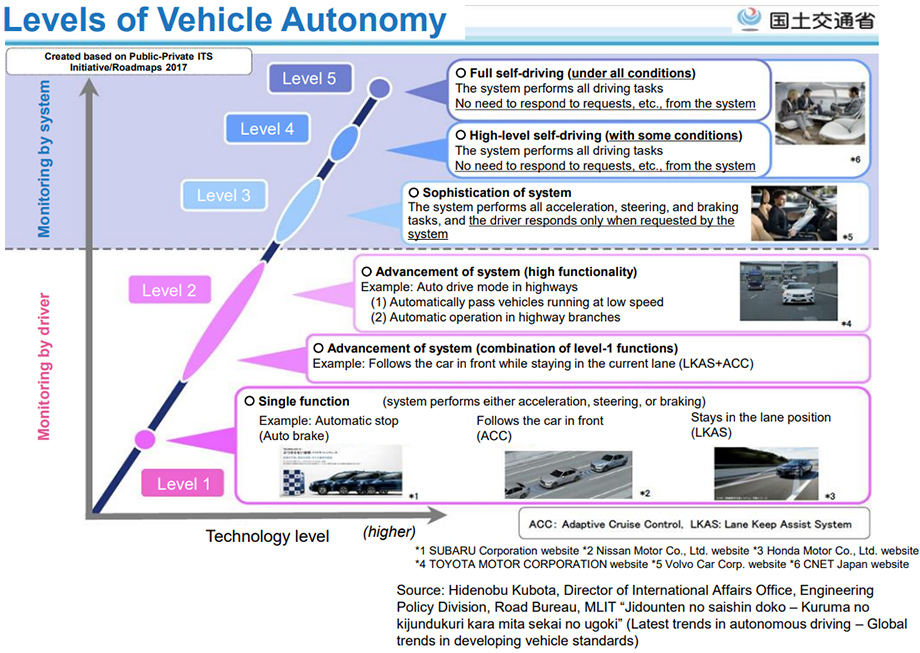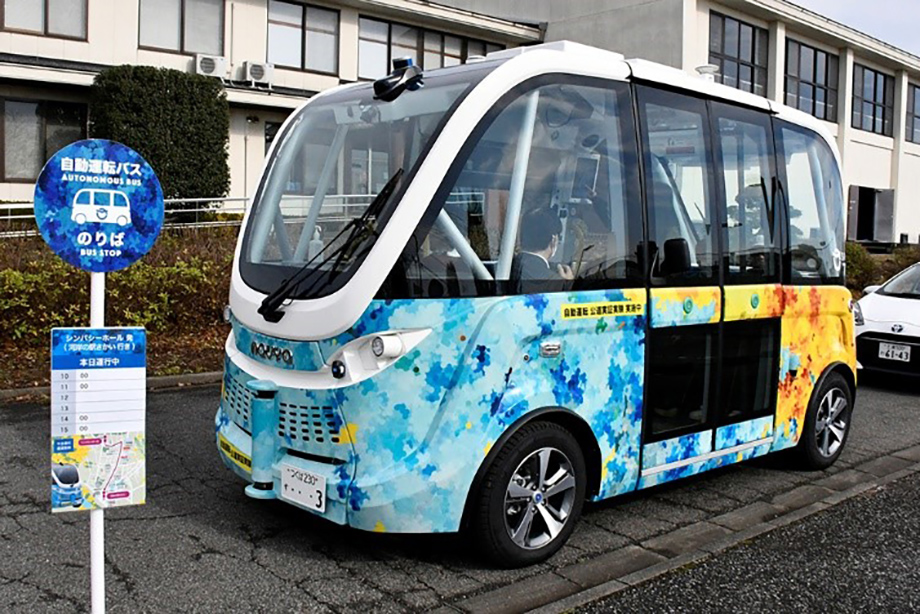Japan leads the world in development of laws related to autonomous driving
The levels of vehicle autonomy are divided into five levels as shown below. Up to Level 3, the laws were created based on the assumption that there will be a driver and that a human would take over in the event of an emergency. Level 4 and above, however, assumes there will be no driver. How should we ensure safety with these conditions? Let us look at the current situations in comparison with global ones.

The progress of autonomous driving varies depending on the legal system of each country. In terms of industry and practical applications, China and the United States are currently leading the pack.
Internationally, the Geneva Conventions, adopted by the United Nations in 1949, and the Vienna Convention on Road Traffic, formulated in 1968 by European countries, are two major road traffic conventions. In the area of autonomous driving, many countries are developing laws in accordance with the uniform rules of these road traffic treaties. However, China is not a member of either convention and can promote autonomous driving only by domestic rules, so they are progressing vehicle production and practical application rapidly.
As for the United States, although it ratified the Geneva Conventions, it has also expressed the view that it should not be limited by a treaty that has never envisioned autonomous driving in the first place. Its domestic rules are based on laws in each state, and sales of vehicles are quick because the company that developed the vehicle can certify itself, instead of type certification as in Japan. Therefore, in the event of an accident, the company takes responsibility.
On the other hand, Japan and Germany lead the world in terms of international legal development.
Self-driving vehicles developed by companies in both countries are verified for their safety, and technology that can be implemented is expected to become a global standard. In the first place, Japan has ratified only the Geneva Conventions and Germany has ratified only the Vienna Convention on Road Traffic, so there were some differences in restrictions. However, we signed a mutual certification agreement that, when we develop a new car and confirm its safety, the other country would accept it, and then we have shared the market. Legislation is being developed almost in unison, including the establishment of detailed vehicle standards and measures to deal with accidents. In the international conference on the social implementation of autonomous driving, which is attended by many countries, Japan and Germany are leading the discussion as chairs or co-chairs.
Laws and regulations must be radically overhauled in driverless driving
The turning point in the development of autonomous driving in Japan was the Motor Show held in Tokyo in 2013 and the Intelligent Transport Systems (ITS) World Congress. It was greatly influenced by the fact that then Prime Minister Shinzo Abe drove a self-driving car on the roads around the National Diet Building, gave a presentation, and issued an order to promote autonomous driving technology as a national strategy. As a result, the Cabinet Secretariat took a leading role, unifying the National Police Agency, which was negative about autonomous driving owing to concerns about accidents, the Ministry of Economy, Trade and Industry (METI), which wanted to promote autonomous driving as a national industry, and the Ministry of Land, Infrastructure, Transport and Tourism (MLIT), which includes the Road Transport Bureau and the Road Bureau. In addition, the Ministry of Internal Affairs and Communications, which governs radio waves essential for autonomous driving, was included in the plan, which was carried out mainly by five ministries and agencies.
Thanks to the introduction of a horizontal collaboration into Japan’s vertically-divided administration, which is considered to be a bad practice in Japan, the process progressed quickly, and from 2015, the issue of legal development began to be examined, followed by demonstration tests for social implementation by the MLIT and the METI. In 2018, the Outline of System Development for Autonomous Driving was published. What is distinctive about this outline is that it examines the way in which a legal system that assumes a transitional period, in which autonomous vehicles and conventional vehicles are mixed, should be established. The autonomous driving technology is still developing in light of international and technological trends, the outline claims that “the system will be revised when new measures are required, assuming a legal system that can respond flexibly.”
Under these circumstances, the revised Road Traffic Act, which permits Level 3 and Level 4 autonomous driving, was enforced in 2020 and 2023, respectively. At the New Risk Study Group of the General Insurance Association of Japan, in which I participated, the group presented the view that the current Act on Securing Compensation for Automobile Accidents and the automobile liability system are appropriate up to Level 3. On the other hand, it points out that Level 4 or higher driverless driving is considered to be separate from conventional vehicles, and that discussions after a fundamental review of laws and regulations concerning automobiles are essential.
If a manufacturer’s designer is held criminally liable for a lack of sufficient safety design, it may hinder the development of technology. Regarding legal liability for accidents involving autonomous driving, it is necessary to separate and clarify civil liability for damages and criminal liability for penalties. In civil liability, the major point is whether there are defects in design or manufacturing. Level 4 autonomous driving requires the installation of an event data recorder (EDR), which records information about the vehicle before and after the accident, and a recording device for driving data.
And in the future, the responsibility of the seller will be questioned more than ever. It is because there will be the obligation to explain the functional limitation of safety equipment to the purchasers in a way that they can fully understand it. There is also a growing argument that if it is not sufficient and an accident occurs owing to a misunderstanding of the system, the seller should take responsibility. When you buy a self-driving car, you may not only get an explanation of important matters and sign it, but also experience the dangers through a simulator. In any case, it is important to educate society not to trust the system too much.
What is needed to get Japanese society to implement autonomous driving?
The current law, which allows Level 4 autonomous driving, requires the implementation of a system like an airport control tower, in which a person monitors the behavior of a car from a remote control center and gives information to the car in an emergency. In order to spread the technology widely throughout society, it is necessary not only to develop such technology, but also to revise the rules for traffic participants, including pedestrians and cyclists, to gain the understand local residents, and to change community development itself, including roads.
Self-driving still has limited functionality, and Level 4 is also applied to limited areas and roads. Autonomous artificial intelligence is good enough for driving on empty highways, but there are many challenges on open roads with traffic lights and pedestrians. For example, if a car does not follow the rules and behaves unexpectedly, such as not following the traffic lights or turning at an intersection rapidly, we still cannot take appropriate action. The area for which drivers used to depend on their intuition and skill is the weak point of autonomous driving.
In order to smoothly incorporate autonomous driving into society by taking their characteristics into account, it is necessary to review and strictly adhere to the rules at the national level. At the same time, it is important to form local rules for each region. For example, in Sakai-machi, Ibaraki, where autonomous buses have been running since November 2020, local residents have been actively cooperating by refraining from parking on the street to make it easier for buses to run, and by providing their own plot as a place where they can stop temporarily to prevent traffic congestion caused by driving too slowly. This is a good example of how autonomous driving is successfully adopted by creating an environment that local residents can watch over approvingly.

In some areas, there are no cars owing to depopulation, so there will be requests to run automatic buses even at 20 km/h. In fact, a demonstration test of the regular operation of an autonomous bus in Kamishihoro-cho in Hokkaido, where the population is declining rapidly, showed that local residents had high needs for the bus, and the bus service continued even after the test period. With the revision of the law to Level 4, it will be necessary for public safety committees in specific areas to listen to the opinions of mayors, town mayors, and residents, and to consider the social implementation of buses in consideration of the situation and local rules in each area.
With the population declining in many developed countries, how to ensure the mobility of people is becoming a pressing issue. If Japan can create a society in which autonomous driving is implemented in coordination with different countries and regions and successfully overcome various issues, it can become a model for the world. We want to work cooperatively in Japan and abroad to that end.
* The information contained herein is current as of January 2024.
* The contents of articles on Meiji.net are based on the personal ideas and opinions of the author and do not indicate the official opinion of Meiji University.
* I work to achieve SDGs related to the educational and research themes that I am currently engaged in.
Information noted in the articles and videos, such as positions and affiliations, are current at the time of production.


